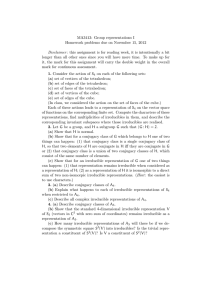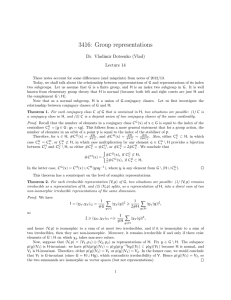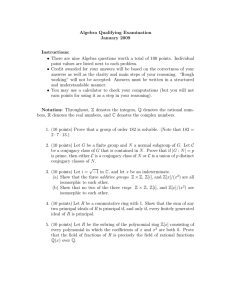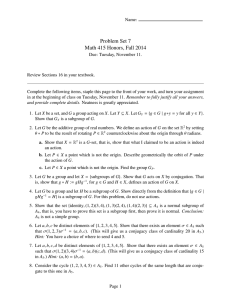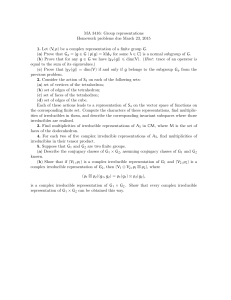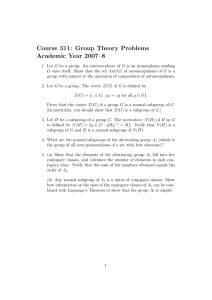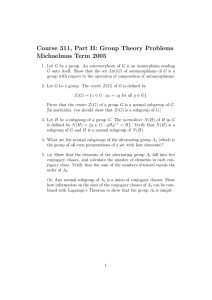THE FULL NONRIGID GROUP THEORY FOR TRIMETHYLAMINE
advertisement
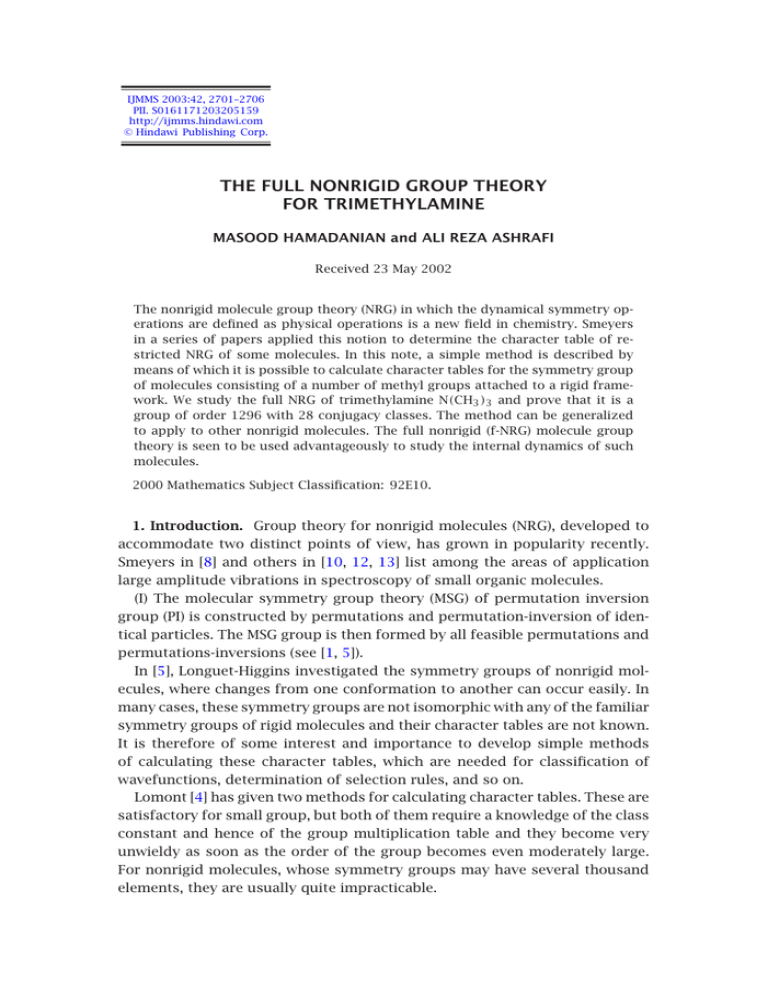
IJMMS 2003:42, 2701–2706
PII. S0161171203205159
http://ijmms.hindawi.com
© Hindawi Publishing Corp.
THE FULL NONRIGID GROUP THEORY
FOR TRIMETHYLAMINE
MASOOD HAMADANIAN and ALI REZA ASHRAFI
Received 23 May 2002
The nonrigid molecule group theory (NRG) in which the dynamical symmetry operations are defined as physical operations is a new field in chemistry. Smeyers
in a series of papers applied this notion to determine the character table of restricted NRG of some molecules. In this note, a simple method is described by
means of which it is possible to calculate character tables for the symmetry group
of molecules consisting of a number of methyl groups attached to a rigid framework. We study the full NRG of trimethylamine N(CH3 )3 and prove that it is a
group of order 1296 with 28 conjugacy classes. The method can be generalized
to apply to other nonrigid molecules. The full nonrigid (f-NRG) molecule group
theory is seen to be used advantageously to study the internal dynamics of such
molecules.
2000 Mathematics Subject Classification: 92E10.
1. Introduction. Group theory for nonrigid molecules (NRG), developed to
accommodate two distinct points of view, has grown in popularity recently.
Smeyers in [8] and others in [10, 12, 13] list among the areas of application
large amplitude vibrations in spectroscopy of small organic molecules.
(I) The molecular symmetry group theory (MSG) of permutation inversion
group (PI) is constructed by permutations and permutation-inversion of identical particles. The MSG group is then formed by all feasible permutations and
permutations-inversions (see [1, 5]).
In [5], Longuet-Higgins investigated the symmetry groups of nonrigid molecules, where changes from one conformation to another can occur easily. In
many cases, these symmetry groups are not isomorphic with any of the familiar
symmetry groups of rigid molecules and their character tables are not known.
It is therefore of some interest and importance to develop simple methods
of calculating these character tables, which are needed for classification of
wavefunctions, determination of selection rules, and so on.
Lomont [4] has given two methods for calculating character tables. These are
satisfactory for small group, but both of them require a knowledge of the class
constant and hence of the group multiplication table and they become very
unwieldy as soon as the order of the group becomes even moderately large.
For nonrigid molecules, whose symmetry groups may have several thousand
elements, they are usually quite impracticable.
2702
M. HAMADANIAN AND A. R. ASHRAFI
In [11], Stone described a method which is appropriate for molecules with a
number of XH3 groups attached to a rigid framework. It is not appropriate in
cases where the framework is linear, as in ethane and dimethylacetylene.
(II) The full and restricted nonrigid group theory (f- or r-NRG) built up with
physical operations, expressed in terms of internal coordinates that transform
one conformation into another one is isoenergetic. The r-NRG is then formed by
the complete set of physical operations which commute with given restricted
or Hamiltonian operators (for details see [6, 7]).
In [9], Smeyers and Villa investigated the r-NRG of planer trimethylamine
and proved that this is a group of order 324. Furthermore, they showed that
this molecule has a pyramidal inversion and so the order of r-NRG of trimethylamine is 648.
In this note, we investigate the f-NRG of pyramidal trimethylamine and prove
that this is a group G of order 1296. Also, we show that this group does not
have a copy of r-NRG of pyramidal trimethylamine. Throughout this note, all
considered groups are assumed to be finite. Our notation is standard and is
taken mainly from [2, 3].
2. Determination of conjugacy classes. First of all, we consider the point
group of the molecule in the case of rigid state. The point group of pyramidal
trimethylamine is C3v . The process of enumerating the symmetry operations
of this molecule and arranging them in classes can be explained as adopting a
numbering convention for the central atom of molecule, central atom of every
CH3 group, and protons nuclei.
Suppose that H is the full nonrigid group of trimethylamine without inversion. It is easy to see that G Z2 ×H. If we compute the conjugacy classes and
character table of H, then using a well-known method for calculating conjugacy classes and character tables of direct product of groups, we can complete
the character table of G. So, it is enough to investigate the conjugacy classes
and character table of H.
The process of enumerating the symmetry operations of this molecule and
arranging them in classes can be explained as adopting a numbering convention for the proton and carbon nuclei. We define the operations α = (5, 6, 7),
β = (8, 9, 10), and γ = (11, 12, 13), which are rotations, in a positive sense for
the three methyl groups. We assume that these operations are all feasible, that
is, that the barrier to rotation of the methyl group is low.
Now we consider the first operation which leaves the framework of the molecule unchanged. Each methyl group can be left alone or rotated through 120◦
in either direction, so that there are 33 = 27 of such operations. These fall into
four classes; the class numbers 1–4 of Table 2.1 show a representative of each,
together with the number of elements in the class. These results are obtained
as follows. First, the operations are grouped according to their cycle structure;
operations which rotate different numbers of methyl groups must belong to
THE FULL NONRIGID GROUP THEORY FOR TRIMETHYLAMINE
2703
Table 2.1. The representatives of conjugacy classes.
No.
Representatives
1
()
2
(5, 6, 7)
3
(5, 6, 7)(8, 9, 10)
Size
1
6
12
4
(5, 6, 7)(8, 9, 10)(11, 12, 13)
5
(5, 7)(11, 13)
27
8
6
(5, 7)(8, 9, 10)(11, 13)
54
7
(3, 4)(8, 13)(9, 11, 10, 12)
54
8
(3, 4)(6, 7)(8, 11)(9, 13)(10, 12)
54
9
(3, 4)(5, 7, 6)(8, 13)(9, 11, 10, 12)
54
10
(3, 4)(5, 6, 7)(8, 12)(9, 13, 10, 11)
54
11
(2, 3, 4)(5, 8, 11)(6, 9, 12)(7, 10, 13)
72
12
(2, 3, 4)(5, 9, 13, 7, 8, 12, 6, 10, 11)
72
13
(2, 3, 4)(5, 10, 12, 6, 8, 13, 7, 9, 11)
14
(3, 4)(6, 7)(8, 12, 10, 13, 9, 11)
72
108
different conjugacy classes. If now we consider the six operations which rotate one methyl group, we can see that they must all belong to the same class
since operations involving rotation of the molecular framework will transform
α into α−1 , β−1 , or γ −1 , changing the sense of the rotation. All of the operations which rotate two methyl groups and all of the operations which rotate
three methyl groups constitute two conjugacy classes of the group.
Consider next the operation which permutes the nuclei of the framework;
these fall into sets corresponding to the classes of C3v . One of the C3 operations
of C3v applied to the framework is the permutation (2, 3, 4), but this is not
feasible for the molecule as the whole, and one has permutated the protons as
well.
We consider the following three permutations:
R1 = (2, 3, 4)(5, 8, 11)(6, 9, 12)(7, 10, 13),
R2 = (2, 3, 4)(5, 9, 13, 7, 8, 12, 6, 10, 11),
(2.1)
R3 = (2, 3, 4)(5, 10, 12, 6, 8, 13, 7, 9, 11).
The permutation R1 denotes the case that the protons of each methyl group
do not rotate. But R2 and R3 apply for the case that these protons rotate. Using
a tedious calculation, we can see that these permutations are not conjugate and
have the same length. Hence, we obtain three conjugacy classes of lengths 72.
2704
M. HAMADANIAN AND A. R. ASHRAFI
Similar methods are applied to the other classes of C3v to derive other conjugacy classes for trimethylamine. We now define
σv1 = (3, 4)(6, 7)(8, 11)(9, 13)(10, 12),
σv2 = (3, 4)(6, 7)(8, 12, 10, 13, 9, 11).
(2.2)
Then we obtain two conjugacy classes of lengths 54 and 108 with the representatives σv1 and σv2 , respectively. Using similar arguments, we can calculate
all of the 14 conjugacy classes of the group H. Since G Z2 × H, we can see
that G has exactly 28 conjugacy classes. In Table 2.1, we give representatives
for the conjugacy classes of H. The conjugacy classes of the group G can be
computed from this table.
3. Determination of character table. From the conjugacy classes of the
group H in Section 2, we can see that H is a group of order 648. First of all, we
denote the conjugacy classes of H and their centralizer orders by the following
two vectors:
A = (1a, 3a, 3b, 3c, 2a, 6a, 3d, 9a, 9b, 4a, 12a, 12b, 6b, 2b),
B = (648, 81, 54, 108, 24, 12, 9, 9, 9, 12, 12, 12, 6, 12).
(3.1)
From Section 2, we can see that H has a normal subgroup T of order 108. Since
the factor group H modulus T is not abelian, so H/T S3 , the symmetric group
on three symbols. Now we obtain three irreducible characters of H by lifting
irreducible characters of S3 . We call these characters χ1 , χ2 , and χ3 and we
have
χ1 = (1, 1, 1, 1, 1, 1, 1, 1, 1, 1, 1, 1, 1, 1),
χ2 = (1, 1, 1, 1, 1, 1, 1, 1, 1, −1, −1, −1, −1, −1),
(3.2)
χ3 = (2, 2, 2, 2, 2, 2, −1, −1, −1, 0, 0, 0, 0, 0).
We now consider the action of H on the set {2, 3, . . . , 13}. If we denote by P the
permutation character of this action, then we have
P = (12, 3, 6, 9, 8, 5, 0, 0, 0, 4, 1, 1, 2, 2).
(3.3)
Since P = 9, (P , χ1 ) = 2, and (P , χ3 ) = 2, P − 2χ1 − 2χ2 is an irreducible character of H, which we denote by χ6 . Consider the symmetric and antisymmetric
parts χS and χA of χ6 (see [2, page 50]). We have
χS = (21, 3, 0, 6, 5, 2, 0, 0, 0, 3, 0, 0, 0, 3),
χA = (15, 6, 0, 3, −1, −1, 0, 0, 0, 1, 1, 1, 0, −3).
(3.4)
2705
THE FULL NONRIGID GROUP THEORY FOR TRIMETHYLAMINE
Table 3.2. The character table of H and its power map.
1a
3a
3b
3c
2a
6a
3d
9a
9b
4a
12a
12b
6b
2b
2P
1a
3a
3b
3c
1a
3c
3d
9a
9b
2a
6a
6a
3b
1a
3P
2b
1a
1a
1a
1a
2a
2a
1a
3a
3a
4a
4a
4a
2b
χ1
1
1
1
1
1
1
1
1
1
1
1
1
1
1
χ2
1
1
1
1
1
1
1
1
1
−1
−1
−1
−1
−1
χ3
2
2
2
2
2
2
−1
−1
−1
0
0
0
0
0
χ4
3
3
3
3
−1
−1
0
0
0
1
1
1
−1
−1
χ5
3
3
3
3
−1
−1
0
0
0
−1
−1
−1
1
1
χ6
6
−3
0
3
2
−1
0
0
0
2
−1
−1
0
0
χ7
6
−3
0
3
2
−1
0
0
0
−2
0
6
−3
0
3
−2
1
0
0
0
0
0
0
χ9
6
−3
0
3
−2
1
0
0
0
0
1
√
− 3
√
3
0
χ8
1
√
3
√
− 3
0
0
χ10
8
−1
2
−4
0
0
−1
2
−1
0
0
0
0
0
χ11
8
−1
2
−4
0
0
−1
−1
2
0
0
0
0
0
χ12
8
−1
2
−4
0
0
2
−1
−1
0
0
0
0
0
χ13
12
3
−3
0
0
0
0
0
0
0
0
0
−1
2
χ14
12
3
−3
0
0
0
0
0
0
0
0
0
1
−2
In addition, χS = 4 and χA = 2. Since (χS , χ1 ) = 1, (χS , χ3 ) = 1, and
(χS , χ6 ) = 1, χS − χ1 − χ3 − χ6 is an irreducible character of H, which we denote by χ14 . On the other hand, χA = 2 and (χA , χ14 ) = 1, so χA − χ14 is an
irreducible character of H, which is denoted by χ4 . Now we define χ7 = χ6 χ2 ,
χ5 = χ4 χ2 , and χ13 = χ14 χ2 , then we obtain three irreducible characters of H
which are different from χ1 , χ2 , χ3 , χ6 , and χ14 .
Finally we consider the character ψ = χ5 χ6 . Then ψ = 3 and (ψ, χ7 ) = 1.
So, ψ −χ7 is a sum of two irreducible characters. Since the square of character
degrees is the order of the group and the number of irreducible characters of
degree n ≥ 3 is even, ψ−χ7 = χ8 +χ2 χ8 , in which χ8 is an irreducible character
of H. Thus, we obtain two new irreducible characters χ8 and χ9 = χ2 χ8 . Using
orthogonality relations, we have
χ8 = 6, −3, 0, 3, −2, 1, 0, 0, 0, 0, 3, − 3, 0, 0 ,
χ9 = 6, −3, 0, 3, −2, 1, 0, 0, 0, 0, − 3, 3, 0, 0 .
(3.5)
Using the character χ6 χ14 and the powers of χ2 , we can obtain other irreducible
characters. We summarize our calculations in Table 3.2, the character table of
the group H. As we mentioned above, since G Z2 × H, we can compute the
character table of G from Table 3.2.
Acknowledgment. We are greatly indebted to the referee whose valuable
suggestions led us to rearrange the note.
2706
M. HAMADANIAN AND A. R. ASHRAFI
References
[1]
[2]
[3]
[4]
[5]
[6]
[7]
[8]
[9]
[10]
[11]
[12]
[13]
Ph. R. Bunker, Molecular Symmetry and Spectroscopy, Academic Press, New York,
1979.
I. M. Isaacs, Character Theory of Finite Groups, Pure and Applied Mathematics,
no. 69, Academic Press, New York, 1976.
G. James and M. Liebeck, Representations and Characters of Groups, Cambridge
Mathematical Textbooks, Cambridge University Press, Cambridge, 1993.
J. S. Lomont, Applications of Finite Groups, Academic Press, New York, 1959.
H. C. Longuet-Higgins, The symmetry groups of non-rigid molecules, Molecular
Phys. 6 (1963), 445–460.
Y. G. Smeyers, Introduction to group theory for non-rigid molecules, Adv. Quantum. Chem 24 (1991), no. 1, 1–77.
Y. G. Smeyers (ed.), Structure and Dynamics of Non-Rigid Molecular Systems,
Kluwer Academic Publishers, Dordrecht, 1995.
Y. G. Smeyers, M. L. Senent, V. Botella, and D. C. Moule, An ab initio structural
and spectroscopic study of acetone—an analysis of the far infrared torsional
spectra of acetone-h6 and -d6, J. Chem. Phys. 98 (1993), no. 4, 2754–2767.
Y. G. Smeyers and M. Villa, A study of the internal dynamics of trimethylamine
by means of the non-rigid group theory, J. Math. Chem. 28 (2000), no. 4,
377–388.
Y. G. Smeyers, M. Villa, and M. L. Senent, Ab initio determination of the torsionwagging and wagging-bending infrared band structure spectrum of methylamine, J. Mol. Spectrosc. 191 (1998), no. 2, 232–238.
A. J. Stone, Computation of character tables for non-rigid molecules, J. Chem.
Phys. 41 (1964), 1568–1579.
Ad van der Avoird, van der Waals rovibration levels and the high resolution spectrum of the argon-benzene dimer, J. Chem. Phys. 98 (1993), no. 7, 5327–
5336.
A. Vivier-Bunge, V. H. Uc, and Y. G. Smeyers, Two-dimensional treatment of the
methyl and aldehydic torsions in gas phase propanal, J. Chem. Phys. 109
(1998), no. 6, 2279–2286.
Masood Hamadanian: Department of Chemistry, Faculty of Science, University of
Kashan, Kashan, Iran
E-mail address: hamadani@kashanu.ac.ir
Ali Reza Ashrafi: Department of Mathematics, Faculty of Science, University of
Kashan, Kashan, Iran
E-mail address: ashrafi@kashanu.ac.ir
